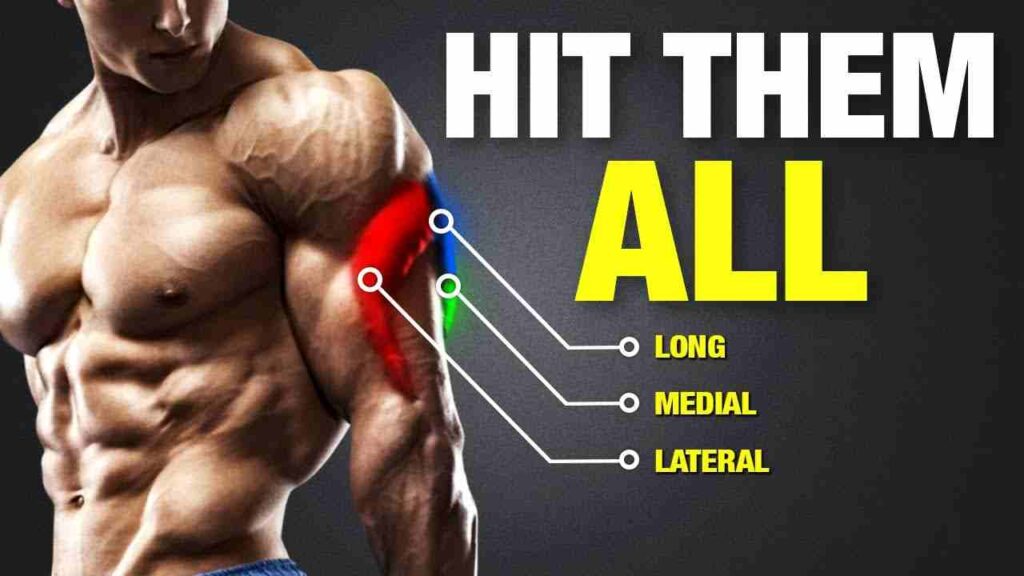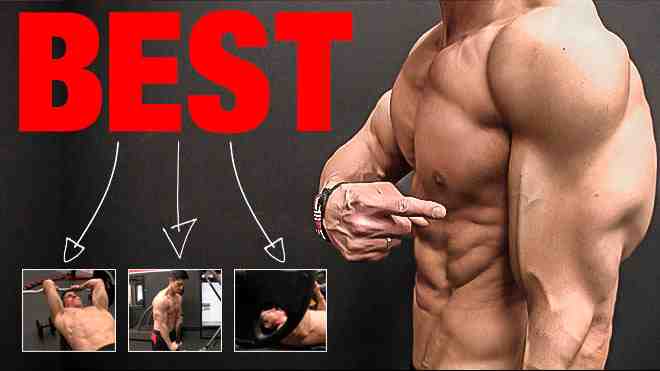Introduction
Are you tired of waving goodbye to flabby triceps when you look in the mirror? It’s time to wave hello to a new and improved you! Kettlebell triceps workouts offer a powerful solution to tone and strengthen those stubborn arm muscles. Whether you’re aiming for sculpted arms that turn heads or just want to enhance your overall strength, these kettlebell exercises are your secret weapon.
In this guide, we’ll unveil the secrets of kettlebell triceps workouts. You’ll discover how to wield this versatile fitness tool to its full potential, achieve impressive triceps gains, and boost your overall fitness level.
Understanding the Triceps Muscle
The triceps brachii, commonly known as the triceps, is a three-headed muscle located on the posterior (back) side of your upper arm. It gets its name from the Latin words “tri” and “ceps,” which mean “three” and “heads,” respectively. The triceps make up a significant portion of your upper arm’s muscle mass and are responsible for various arm movements.
Why Are the Triceps Important?
The triceps play a crucial role in several essential functions, making them important for both aesthetics and functional strength:
- Arm Extension: The primary function of the triceps is to extend the elbow joint, which straightens your arm. This action is involved in everyday activities like pushing, lifting, and reaching.
- Stabilization: Strong triceps are vital for stabilizing the shoulder joint and supporting various upper-body movements.
- Aesthetics: Well-developed triceps contribute to the overall appearance of your arms. They provide the coveted “horseshoe” shape and can make your arms look toned and muscular.
Understanding the triceps muscle’s anatomy and function is the first step in creating an effective kettlebell triceps workout routine.
How Can Kettlebell Workouts Benefit Your Triceps?
Kettlebell workouts can benefit your triceps in several ways:
- Targeted Triceps Engagement: Kettlebell exercises specifically target the triceps muscle, allowing for concentrated and effective training.
- Enhanced Triceps Strength: Regular kettlebell workouts lead to increased triceps strength, enabling you to perform daily tasks more effortlessly and excel in other upper body exercises.
- Definition and Tone: Kettlebell exercises promote muscle definition and toning in the triceps, leading to a sculpted appearance that looks great and boosts confidence.
- Improved Upper Body Functionality: Stronger triceps improve your overall upper body functionality, aiding in activities like lifting, pushing, and carrying objects.
- Enhanced Metabolism: Kettlebell workouts are intense and can elevate your heart rate, resulting in improved metabolism and more efficient calorie burning, which can contribute to weight management.
- Joint Health: Proper kettlebell form and controlled movements can help strengthen the joints, reducing the risk of injury and promoting long-term joint health, especially in the elbows.
- Versatility and Convenience: Kettlebell exercises can be adapted to different fitness levels and are convenient for home workouts. This versatility allows individuals of all backgrounds to reap the benefits of triceps training with kettlebells.
Kettlebell workouts benefit your triceps by providing targeted exercises, functional strength, workout variety, enhanced stabilization, and efficient calorie burning. Incorporating kettlebell triceps exercises into your fitness routine can lead to stronger and more defined triceps.
Kettlebell Basics
Kettlebells are cast iron weights with a unique design. They consist of a handle attached to a round, compact mass, which sets them apart from traditional dumbbells and barbells. This design allows for dynamic and functional movements, making kettlebells a fantastic choice for full-body workouts, including triceps exercises.
Advantages of Kettlebells
Kettlebells offer several advantages for triceps workouts:
- Versatility: Kettlebells can be used for a wide range of exercises, from triceps extensions to swings and more. This versatility allows you to create diverse and effective workout routines.
- Functional Strength: Kettlebell exercises often mimic real-life movements, promoting functional strength that can improve your daily activities.
- Cardiovascular Benefits: Many kettlebell exercises provide both strength training and cardio benefits, helping you burn calories while building muscle.
Choosing the Right Kettlebell Weight
Selecting the appropriate kettlebell weight is crucial to ensure that your triceps workouts are both effective and safe. Here’s how to determine the right weight for you:
- Start Light: If you’re new to kettlebell training, begin with a lighter weight to learn proper form and reduce the risk of injury. A 10-15 pound (4.5-6.8 kg) kettlebell is a good starting point for many beginners.
- Progress Gradually: As you become more comfortable with the exercises and your strength increases, you can gradually increase the weight of your kettlebell.
- Consult a Trainer: If you’re unsure which weight to choose or if you have any underlying health concerns, consider consulting a fitness professional or trainer for personalized guidance.
Proper Form and Safety Tips
Maintaining proper form is essential for a safe and effective kettlebell triceps workout. Here are some key tips to keep in mind:
- Maintain a Neutral Spine: Keep your back straight and engage your core muscles to protect your spine. Avoid rounding your back.
- Use Your Hips and Legs: Many kettlebell exercises involve hip and leg movements. Properly engaging these muscle groups will help you generate power and protect your lower back.
- Start with Low Repetitions: Begin with a lower number of repetitions to ensure you can maintain good form throughout the exercise.
- Warm-Up and Cool Down: Always warm up before your workout with light cardio and dynamic stretches. After your workout, cool down with static stretches to prevent muscle soreness.
Remember to choose the right kettlebell weight, maintain proper form, and stay safe throughout your workouts. With these fundamentals in mind, you’ll be well-prepared to embark on your kettlebell triceps workout adventure.
Kettlebell Triceps Workout
Kettlebell triceps exercises are a fantastic way to target and tone the muscles on the back of your arms. These exercises not only help you achieve stronger triceps but also contribute to your overall upper-body strength. Below, we’ll explore some effective kettlebell triceps exercises;
1. Kettlebell Triceps Extension
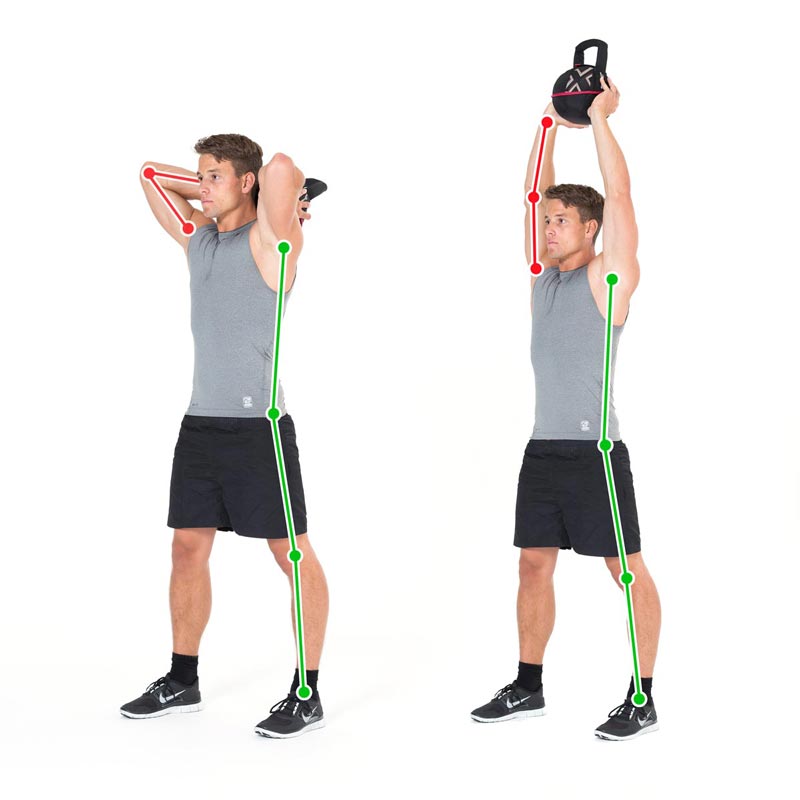
The kettlebell triceps extension is a fundamental exercise that targets your triceps, helping you build strength and definition.
How to Perform:
- Begin by standing with your feet shoulder-width apart, holding the kettlebell with both hands above your head.
- Keep your elbows close to your ears and your core engaged.
- Slowly lower the kettlebell behind your head by bending your elbows.
- Extend your arms to raise the kettlebell back up, focusing on your triceps.
Tips:
- Use a comfortable weight to start, and gradually increase as you gain strength.
- Keep your back straight and avoid arching it during the movement.
Variations:
- Single-arm kettlebell triceps extension for unilateral work.
- Seated kettlebell triceps extension for added stability.
2. Kettlebell Triceps Press
The kettlebell triceps press is excellent for isolating and strengthening your triceps.
How to Perform:
- Lie flat on your back with your knees bent and feet flat on the floor.
- Hold the kettlebell with both hands, arms extended directly above your chest.
- Lower the kettlebell by bending your elbows until it hovers just above your forehead.
- Push the kettlebell back up to the starting position, fully extending your arms.
Tips:
- Maintain a stable core and avoid excessive arching of your back.
- Start with a lighter weight to ensure proper form.
Variations:
- Incline kettlebell triceps press for a different angle.
- Using a resistance band for added resistance.
3. Kettlebell Skull Crushers
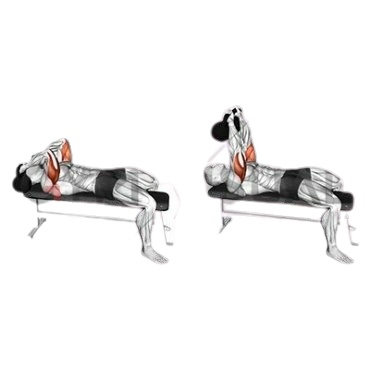
Kettlebell skull crushers are an effective triceps exercise that isolates and targets the back of your arms.
How to Perform:
- Lie flat on a bench with a kettlebell in each hand, arms extended directly over your chest.
- Bend your elbows to lower the kettlebells towards your forehead while keeping your upper arms stationary.
- Pause briefly when the kettlebells are close to your forehead, then extend your arms to return to the starting position.
Tips:
- Use a spotter or perform this exercise with lighter weights to prevent injury.
- Keep your upper arms perpendicular to the floor throughout the movement.
Variations:
- Single-arm kettlebell skull crushers for unilateral work.
- Decline kettlebell skull crushers for added intensity.
4. Kettlebell Triceps Dips

Kettlebell triceps dips are a bodyweight exercise that can be enhanced with kettlebells for added resistance.
How to Perform:
- Position two kettlebells on the floor, parallel to each other, and grip the handles with your palms facing each other.
- Sit on the edge of one kettlebell with your hands securely on the handles.
- Lift your hips off the ground, supporting your weight with your hands and keeping your feet on the floor.
- Bend your elbows to lower your body toward the ground, then push back up to the starting position.
Tips:
- Start with a shallow dip and gradually increase the depth as you gain strength.
- Keep your shoulders down and away from your ears.
Variations:
- Add weight by placing a kettlebell on your lap.
- Use a stability ball or bench for a different angle and challenge.
5. Kettlebell Triceps Kickbacks
Kettlebell triceps kickbacks are a dynamic exercise that focuses on the triceps’ posterior head, helping to tone and strengthen the back of your arms.
How to Perform:
- Begin by standing with your feet hip-width apart, holding a kettlebell in each hand.
- Bend your knees slightly and hinge forward at your hips, keeping your back straight and chest up.
- Your upper arms should be parallel to the floor, and your elbows should be bent at a 90-degree angle.
- Extend your arms straight back, squeezing your triceps at the top of the movement.
- Hold for a moment, then return to the starting position.
Tips:
- Maintain a stable core and neutral spine throughout the exercise.
- Use controlled movements and avoid swinging the kettlebells.
Variations:
- Single-arm kettlebell triceps kickbacks for unilateral work.
- Use a resistance band for a different type of resistance and variation.
6. Kettlebell Overhead Triceps Extension
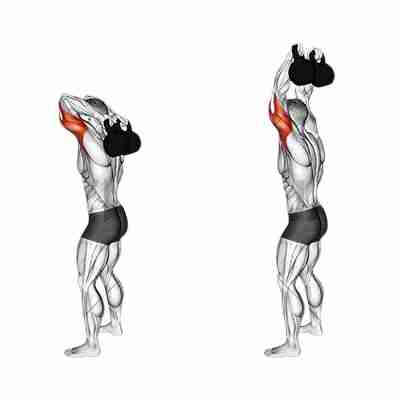
The kettlebell overhead triceps extension is a powerful exercise to target your triceps while engaging your core for stability.
How to Perform:
- Begin by standing or sitting with your back straight and holding a kettlebell with both hands, palms facing upward.
- Raise the kettlebell overhead, fully extending your arms.
- Keep your elbows close to your ears and ensure that the kettlebell is securely gripped.
- Slowly lower the kettlebell behind your head, bending your elbows.
- Pause briefly when your elbows reach a 90-degree angle or slightly lower.
- Extend your arms, raising the kettlebell back overhead.
Tips:
- Use a comfortable weight to start and progress cautiously.
- Focus on keeping your core engaged and maintaining a stable posture.
Variations:
- Seated kettlebell overhead triceps extension for added stability.
- Single-arm kettlebell overhead triceps extension for unilateral work.
7. Kettlebell Triceps Push-Up
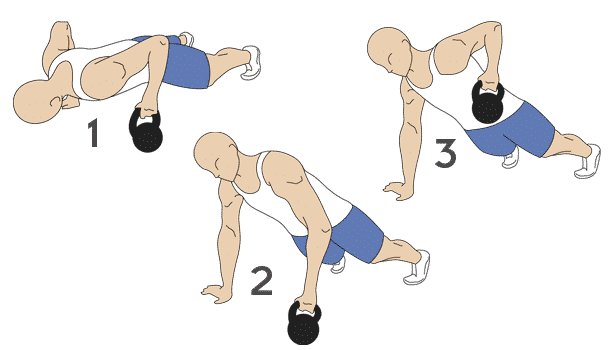
Kettlebell triceps push-ups are a challenging variation of the traditional push-up that places extra emphasis on the triceps.
How to Perform:
- Place two kettlebells on the floor, shoulder-width apart, with the handles parallel to each other.
- Get into a push-up position with your hands gripping the kettlebell handles and your body in a straight line from head to heels.
- Lower your chest towards the ground by bending your elbows, keeping them close to your body to emphasize triceps engagement.
- Push yourself back up to the starting position by extending your arms fully.
Tips:
- Maintain a strong core and keep your body in a straight line throughout the movement.
- Start with a modified knee push-up version if full push-ups are too challenging.
Variations:
- Elevate your feet on a bench or box for an added challenge.
- Place your hands closer together on the kettlebell handles for a narrower hand placement.
Incorporating these kettlebell triceps exercises into your workout routine will help you achieve stronger, more defined arms over time. Remember to start with an appropriate kettlebell weight, focus on proper form, and gradually increase the intensity to see optimal results.
Creating a Kettlebell Triceps Workout Plan
A well-structured kettlebell triceps workout plan is essential for achieving the best results and safely building strength and definition in your triceps. Here, I’ve outlined a 4-week kettlebell triceps workout plan that gradually increases in intensity.
Week 1: Getting Started (2-3 Days per Week)
1. Kettlebell Triceps Extension:
- Perform 3 sets of 12-15 reps.
- Focus on perfecting your form and maintaining control throughout the exercise.
- Use a comfortable kettlebell weight to avoid straining your triceps.
2. Kettlebell Triceps Dips:
- Perform 3 sets of 10-12 reps.
- Use a stable surface, like parallel bars or a bench, to perform dips.
- If you can’t complete the repetitions, use assistance from a band or bench.
Week 2: Building Strength (3 Days per Week)
1. Kettlebell Triceps Extension:
- Perform 3 sets of 15-20 reps.
- Increase the weight slightly from the previous week.
- Focus on a controlled eccentric (lowering) phase for maximum muscle engagement.
2. Kettlebell Triceps Dips:
- Perform 3 sets of 12-15 reps.
- Continue to work on your form and gradually decrease the assistance used.
Week 3: Intensifying the Work (3-4 Days per Week)
1. Kettlebell Triceps Extension:
- Perform 4 sets of 15-20 reps.
- Slightly increase the weight to challenge your triceps further.
- Maintain a steady pace and focus on the mind-muscle connection.
2. Kettlebell Triceps Press:
- Perform 3 sets of 10-12 reps per arm.
- Start with a moderate weight and perform single-arm presses for better isolation.
- Ensure your core is engaged to stabilize your body.
Week 4: Advanced Challenge (4-5 Days per Week)
1. Kettlebell Triceps Extension:
- Perform 4 sets of 20-25 reps.
- Increase the weight if you can maintain proper form.
- Use a controlled tempo to maximize the burn in your triceps.
2. Kettlebell Triceps Press:
- Perform 4 sets of 10-12 reps per arm.
- Use a challenging weight and focus on strict form.
- Rest between sets to maintain strength and endurance.
3. Kettlebell Triceps Kickbacks:
- Perform 3 sets of 12-15 reps per arm.
- This exercise adds variety to your routine and targets the triceps differently.
- Maintain a neutral spine and engage your core.
Tips for Success
- Warm up before each session with light cardio and dynamic stretches.
- Ensure proper form to prevent injuries and maximize results.
- Gradually increase the weight as you become more comfortable with each exercise.
- Rest for 48 hours between working the same muscle group to allow for recovery.
- Stay consistent and progressively challenge yourself to see the best results.
Remember that everyone’s progress may vary, so listen to your body and adjust the plan accordingly.
FAQs
Q 1. Can anyone do kettlebell triceps workouts?
Ans. Yes, kettlebell triceps workouts can be adapted to various fitness levels. Beginners should start with lighter weights and focus on proper form, while more experienced individuals can increase the weight and intensity as needed.
Q 2. How often should I perform kettlebell triceps exercises?
Ans. It’s recommended to include triceps workouts 2-3 times a week for best results. Allow your muscles to rest between sessions to promote recovery and growth.
Q 3. What’s the ideal time to see results from kettlebell triceps workouts?
Ans. The timeline for results can vary from person to person, but with consistent effort, you may start to notice improvements in triceps strength and definition within 4-6 weeks.
Q 4. Are kettlebell triceps workouts suitable for beginners?
Ans. Yes, kettlebell triceps workouts can be beginner-friendly when performed with the proper form and the right weight. Always start with a weight you can comfortably manage to prevent injuries.
Q 5. Can I use other equipment in combination with kettlebells?
Ans. Yes, you can incorporate other equipment like resistance bands or dumbbells to add variety and challenge to your triceps workouts. Just ensure you maintain proper form and safety precautions.
Conclusion
In conclusion, kettlebell triceps workouts are a highly effective way to strengthen and tone your triceps. With the right exercises, proper form, and a consistent workout plan, you can achieve impressive results.
Whether you’re a beginner or experienced, kettlebell triceps workouts offer a versatile and challenging option for enhancing your upper body strength and achieving the arms you desire.

Good day, and welcome to Fitthour. My name is Shubham Vijay, and I am a certified personal trainer and nutrition coach with 6 years of experience in the fitness industry. At Fitthour, we specialize in types of training, such as strength training, cardio, or HIIT, and our mission is to help clients achieve their fitness goals and improve their overall health.

